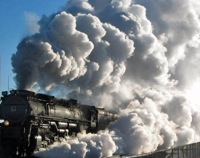Steam
Etymology
Middle English stem, from Old English stēam; akin to Dutch stoom steam
- Date: before 12th century
Definitions
- 1 : a vapor arising from a heated substance
- 2 a : the invisible vapor into which water is converted when heated to the boiling point
- b : the mist formed by the condensation on cooling of water vapor
- 3 a : water vapor kept under pressure so as to supply energy for heating, cooking, or mechanical work; also : the power so generated
- b : active force : power, momentum <got there under his own steam> <sales began to pick up steam>; also : normal force <at full steam>
- c : pent-up emotional tension <needed to let off a little steam>
- 4 a : steamer 2a b : travel by or a trip in a steamer
Description
Steam is either mist (as seen from a kettle), or the gas phase of water (water vapor).
In common speech, steam most often refers to the visible white mist that condenses above boiling water as the hot vapor mixes with the cooler air. This mist consists of tiny droplets of liquid water. Pure steam emerges at the base of the spout of a steaming kettle where there is no visible vapor.
Pure steam is a transparent gas. At standard temperature and pressure, pure steam (unmixed with air, but in equilibrium with liquid water) occupies about 1,600 times the volume of an equal mass of liquid water. In the atmosphere, the partial pressure of water is much lower than 1 atm, therefore gaseous water can exist at temperatures much lower than 100 °C (212 °F) (see water vapor and humidity).[1]
